Toshiba B-EX6T1-TS12-QM-R User Manual

TOSHIBA Bar Code Printer
Printer Driver
Operating Manual
15th Edition: |
May 31, 2016 |

|
|
Table of Contents |
|
INTRODUCTION .................................................................................................................................................... |
1 |
||
1. GENERAL DESCRIPTION................................................................................................................................. |
2 |
||
1.1 |
Features..................................................................................................................................................... |
2 |
|
1.2 |
Applicable printers ..................................................................................................................................... |
2 |
|
1.3 |
Notation...................................................................................................................................................... |
4 |
|
1.4 |
Screens Used in This Document ............................................................................................................... |
4 |
|
1.5 |
Trademark and Copyright .......................................................................................................................... |
4 |
|
1.6 |
Operational Conditions .............................................................................................................................. |
6 |
|
1.6.1 |
Operation System .............................................................................................................................. |
6 |
|
1.6.2 |
Hardware............................................................................................................................................ |
6 |
|
1.7 |
Cautions for Installation (IMPORTANT)..................................................................................................... |
6 |
|
2. INSTALLATION PROCEDURE........................................................................................................................ |
15 |
||
Preparatory Procedure Common to All Models ................................................................................................ |
15 |
||
2.1 |
Preparation for Installation....................................................................................................................... |
17 |
|
2.2 |
Installation under Windows 2000/XP/Server2003 ................................................................................... |
19 |
|
2.3 |
Installation under Windows Vista/Server2008/7/Server2008R2/8 ................................................................. |
26 |
|
2.4 |
Installation under Windows 2000 (USB with Plug & Play Enabled) ........................................................ |
35 |
|
2.5 |
Installation under Windows XP/Server2003 (USB with Plug & Play enabled) ........................................ |
38 |
|
2.6 |
Installation under Windows Vista/Server 2008/7/Server2008R2/8 (USB with Plug & Play Enabled) ..... |
40 |
|
2.7 |
Installation under Windows 2000 (Parallel interface with Plug & Play Enabled)..................................... |
41 |
|
2.8 |
Installation under Windows XP/Server2003 (Parallel interface with Plug & Play Enabled) .................... |
44 |
|
2.9Installation under Windows Vista/Server2008/7/Server2008R2/8 (Parallel Interface with Plug & Play
Enabled) |
............................................................................................................................................................ |
46 |
|
2.10 |
Uninstalling ..................................................................................................................the Printer Driver |
47 |
|
2.10.1 ..........................................To delete the printer drivers except for V6.5 Build75 and V6.5 Build77 |
47 |
||
2.10.2 .....................................................................................To delete the V6.5 Build75 or V6.5 Build77 |
50 |
||
3. Functions............................................................................................................................................ |
51 |
||
3.1 |
Page .......................................................................................................................................Setup Tab |
57 |
|
3.1.1 ......................................................................Registering a new stock or editing the existing stock |
58 |
||
3.1.2 ............................................................................................................................................... |
Preset |
61 |
|
3.1.3 ............................................................................................................................ |
Advanced Options |
62 |
|
3.2 |
Graphics ...........................................................................................................................................Tab |
65 |
|
3.3 |
Stock .................................................................................................................................................Tab |
66 |
|
3.4 |
Options ..............................................................................................................................................Tab |
69 |
|
3.4.1 .............................................................................Multiple Part Print Area Settings (B-EV4-G only) |
70 |
||
3.4.2 ......................................................................................................................... |
Ribbon Adjustments |
72 |
|
3.5 |
Fonts .................................................................................................................................................Tab |
73 |
|
3.5.1 .................................................................................................................................. |
Bar Code Font |
77 |
|
3.6 |
Tools ..................................................................................................................................................Tab |
79 |
|
3.7 |
Designation ......................................................................................................................of Printer Font |
89 |
|
4. System ..........................................................................................................................Configuration |
93 |
||
4.1 |
System ...............................................................................................................Configuration Example |
94 |
|
5. Addition/Deletion .........................................................................................of Standard TCP/IP Port |
96 |
||
5.1 |
Addition .................................................................................................................................................... |
97 |
|
5.2 |
Deletion.................................................................................................................................................. |
100 |
|
6. Appendix ............................................................................................................................................. |
101 |
||
6.1 |
How ..........................................................................to Enable Bi-directional Communication Support |
101 |
|
6.2 |
Parameter ...........................................................................................................Setting on the Printer |
102 |
|
6.3 |
How ........................................................................................................to Connect the Printer to LAN |
103 |
|
Copyright © 2016
by TOSHIBA TEC CORPORATION All Rights Reserved
570 Ohito,Izunokuni-shi,Shizuoka-ken,JAPAN

Introduction
Thank you for purchasing the TOSHIBA bar code printer.
This document gives you a general description of the installation, operation, and functions of the TPCL*-enabled printer driver (BDRV-WBX8-Z31 Version 7.4.1 M-3).
The latest printer driver can be downloaded from TOSHIBA TEC bar code system website at the following URL:
http://www.toshibatec.com/download_overseas/printer/printer_driver/
* TPCL: Abbreviation of TEC Printer Control Language
- 1 -

1. General Description
1.1Features
This product is a printer driver designed for TOSHIBA bar code printer and used under Windows 2000, Windows XP, Windows Server 2003, Windows Vista, Windows Server 2008, Windows 7, Windows Server 2008 R2, Windows 8, Windows 8.1, Windows Server 2012, Windows Server 2012 R2 or Windows 10.
Note: Windows 2000 is not supported though installation of this product is possible.
zEnables easy printing from Windows applications.
zEnables a use of the bar code printer just like an office-use laser or ink jet printer, even if you do not know bar code printer specific commands.
zEnables easy setup of the label size, sensors, cut operation, and other functions unique to the bar code printer.
zThe host PC is connectable to the printer with RS-232C, Parallel, USB, LAN or Bluetooth.
Note: Usable interface type varies depending on the printer models. For details, please refer to the Owner’s Manual of the printer. Bluetooth and IrDA are not supported.
zThe bar code printer’s built-in fonts can be used as well as Windows TrueType fonts.
zBar codes and 2D codes can be printed only by registering a desired code as a font in the printer driver.
1.2Applicable printers
B-452-R |
B-452-TS-R |
|
|
B-852-R |
B-852-TS22-QQ/QP-R |
|
|
B-EP2DL-G |
B-EP2DL-GH20/GH30/GH40-QM-R |
|
|
B-EP4DL-G |
B-EP4DL-GH20/GH30/GH40-QM-R |
|
|
B-EV4 |
B-EV4D-G, B-EV4T-G |
(203 dpi) |
|
B-EV4 |
B-EV4D-T, B-EV4T-T |
(300 dpi) |
|
B-SA4T |
B-SA4TM-GS12-QM-R, |
(203 dpi) |
B-SA4TP-GS12-QM-R |
B-SA4T-CN |
B-SA4TM-GS12-CN-R, |
(203 dpi) |
B-SA4TP-GS12-CN-R |
B-SA4T |
B-SA4TM-TS12-QM-R, |
(300 dpi) |
B-SA4TP-TS12-QM-R |
B-SA4T-CN |
B-SA4TM-TS12-CN, |
(300 dpi) |
B-SA4TP-TS12-CN |
B-SV4 |
B-SV4D-QM/QM-R/CGE/CGE-R/CN/ |
|
QQ-US |
|
B-SV4T-QM-R |
|
|
B-SX4T |
B-SX4T-GS10-QQ/QQ-US/QP, |
(203 dpi) |
B-SX4T-GS20-QQ/QQ-US/QP/QM-R |
|
|
B-SX4T-CN |
B-SX4T-GS10-CN, |
(203 dpi) |
B-SX4T-GS20-CN/CN-R |
|
|
B-SX5T |
B-SX5T-TS12-QQ/QQ-US/QP, |
(305 dpi) |
B-SX5T-TS22-QQ/QQ-US/QP/QM-R |
B-SX5T-C |
B-SX5-TS12-CN, |
N (305 dpi) |
B-SX5T-TS22-CN/CN-R |
B-SX6T |
B-SX6T-TS12-QM-R |
(305 dpi) |
|
B-SX8T |
B-SX8T-TS12-QM-R |
(305 dpi) |
|
B-EX4T1 |
B-EX4T1-GS12-QM/CN-R |
(203 dpi) |
|
B-EX4T1 |
B-EX4T1-TS12-QM/CN-R |
(305 dpi) |
|
B-EX4T2 |
B-EX4T2-GS12-QM/CN-R |
(203 dpi) |
B-EX4D2-GS12-QQ/QM-R |
B-EX4T2 |
B-EX4T2-TS12-QM/CN-R |
(300 dpi) |
|
B-EX4T2 |
B-EX4T2-HS12-QM/CN-R |
(600 dpi) |
|
B-462-R |
B-462-TS22-CN-R |
|
|
B-FV4 |
B-FV4T-GS12/GS14/GS16-QM-R, |
(203 dpi) |
B-FV4T-GS14/GS16-CN-R, |
|
B-FV4D-GS12/GS14/GS16-QM-R, |
|
B-FV4D-GS14/GS16-CN-R, |
|
B-FV4D-GH14-QM-R, |
|
B-FV4D-GL14-QM-R |
B-FV4 |
B-FV4T-TS12/TS14/TS16-QM-R, |
(300 dpi) |
B-FV4T-TS14/TS16-CN-R, |
|
B-FV4D-TS12/TS14/TS16-QM-R, |
|
B-FV4D-TS14/TS16-CN-R |
B-FP3D |
B-FP3D-GH30-QM-R |
(203 dpi) |
B-FP3D-GH40-QM-R |
|
B-FP3D-GS30-QM-R |
|
B-FP3D-GS40-QM-R |
- 2 -
B-EX6T1 |
B-EX6T1-GS12-QM/CN-R |
B-EX6T3 |
B-EX6T3-GS12-QM/CN-R |
|
B-EX6T1-TS12-QM/CN-R |
|
B-EX6T3-TS12-QM/CN-R |
- 3 -
1.3Notation
zNames of menus, screens, icons, buttons, tabs, and items are enclosed in square brackets ([ ]). For example: Click the [OK] button.
zWordings shown on the computer monitor and the LCD message display of your printer are enclosed in double quotation marks (“ “).
For example: “ON LINE”.
zTitles of the chapters and sections to be referred to are expressed in bold and Italic.
For example: Please refer to Section 1.1 Features.
1.4Screens Used in This Document
Screens shown in this document are examples used for explaining operations. Unless otherwise specified, an operation system used in this document is Windows XP. Please note that the screens shown may differ depending on your usage environment and conditions.
1.5Trademark and Copyright
Microsoft and Windows are trademarks of Microsoft Corporation in the United States and other countries. Other company and product names may be registered trademarks or trademarks of others.
Each company’s registered trademarks and trademarks are not marked with TM or ®. This document uses the following abbreviations.
•Microsoft® Windows® 2000 Professional operating system and Microsoft® Windows® 2000 Server operating system: Windows 2000
•Microsoft® Windows® XP Home Edition operating system and Microsoft® Windows® XP Professional operating system: Windows XP
•Microsoft® Windows® Server 2003, Standard Edition operating system, Microsoft® Windows®
Server 2003, Enterprise Edition operating system, Windows® Server 2003, Datacenter Edition operating system, Windows® Server 2003, Web Edition operating system, Microsoft® Windows® Server 2003 R2, Standard Edition operating system, Microsoft® Windows® Server 2003 R2, Enterprise Edition operating system, Microsoft® Windows® Server 2003 R2, Datacenter Edition operating system, and Microsoft® Windows® Server 2003 R2, Web Edition operating system: Windows Server 2003
•Microsoft® Windows® Vista Ultimate operating system and Microsoft® Windows® Vista Enterprise operating system and Microsoft® Windows® Vista Business operating system and Microsoft® Windows® Vista Home Premium operating system and Microsoft® Windows® Vista Home Basic operating system: Windows Vista
•Microsoft® Windows® Server 2008, Standard Edition operating system, Microsoft® Windows®
Server 2008, Enterprise Edition operating system, Microsoft® Windows® Server 2008, Datacenter Edition operating system and Microsoft® Windows® Web Server 2008 Edition operating system: Windows Server 2008
•Microsoft® Windows® 7 Ultimate operating system and Microsoft® Windows® 7 Enterprise
operating system and Microsoft® Windows® 7 Professional operating system and Microsoft® Windows® 7 Home Premium operating system: Windows 7
•Microsoft® Windows® Server 2008 R2, Standard Edition operating system, Microsoft® Windows®
Server 2008 R2, Enterprise Edition operating system, Microsoft® Windows® Server 2008 R2, Datacenter Edition operating system and Microsoft® Windows® Web Server 2008 R2 Edition operating system: Windows Server 2008 R2
•Microsoft® Windows® 8 Enterprise operating system and Microsoft® Windows® 8 Professional operating system and Microsoft® Windows® 8 operating system and Microsoft® Windows® 8.1 Enterprise operating system and Microsoft® Windows® 8.1 Professional operating system and Microsoft® Windows® 8.1 operating system: Windows 8
•Microsoft® Windows® Server 2012, Standard Edition operating system, Microsoft® Windows®
Server 2012, Enterprise Edition operating system, Microsoft® Windows® Server 2012, Datacenter Edition operating system and Microsoft® Windows® Web Server 2012 Edition operating system: Windows Server 2012
•Microsoft® Windows® Server 2012 R2, Standard Edition operating system, Microsoft® Windows®
-4 -
Server 2012 R2, Enterprise Edition operating system, Microsoft® Windows® Server 2012 R2, Datacenter Edition operating system and Microsoft® Windows® Web Server 2012 R2 Edition operating system: Windows Server 2012 R2
•Microsoft® Windows® 10 Enterprise operating system and Microsoft® Windows® 10 Professional operating system and Microsoft® Windows® 10 operating system: Windows 10
- 5 -
1.6Operational Conditions
This product can be used under the following system requirements.
1.6.1Operation System
Windows 2000, Windows XP, Windows Server 2003, Windows Vista, Windows Server 2008, Windows 7 (32 bit/64 bit), Windows Server 2008 R2, Windows 8 (32 bit/64 bit), Windows Server 2012, Windows Server 2012 R2 or Windows 10 (32 bit/64 bit).
Notes: 1. 64-bit operating systems except Windows 7, Windows Server 2008 R2, Windows 8, Windows Server 2012, Windows Server 2012 R2 and Windows 10 are not applicable.
2.Windows 2000 is not supported though installation of this product is possible.
1.6.2Hardware
A DOS/V (IBM AT compatible) machine running the above Windows operation system must be used along with the following mandatory or recommended requirements.
|
Requirement |
Recommendation |
CPU |
Intel® Pentium® II 400MHz or greater |
Intel® Pentium® III 1GHz or greater |
Memory |
64MB or more |
256MB or more |
HDD |
10MB or more free size |
|
1.7Cautions for Installation (IMPORTANT)
Please be sure to read the following cautions before using this product.
zWhen you are going to install an upgraded version of the TEC printer driver, you must first uninstall the older version in advance. For how to uninstall the printer driver, refer to Section 2.10 Uninstalling the
Printer Driver.
Failure to do so may cause unstable printing operations due to the influences of the files and registry related to the old version remaining in the system. Follow the procedure in Section 2.10 Uninstalling the Printer Driver, and the files and registry related to the printer driver will be deleted from the system.
Note: • This printer driver uses common program for the all applicable printer models.
•Even if the printer model is different, TPCL printer driver of different version cannot be used on the same PC.
•When installing TPCL printer driver for a new model on the PC in which the TPCL printer driver of different version for another printer model has been already installed, the existing printer driver needs to be deleted.
- 6 -

zBe sure to set the [Printer Status Monitoring] as shown in the table below. The status monitor has been disabled as default. Wrong setting disables proper printing.
Configuration for the Status Monitor
When the [Printer Status Monitoring] is set to other than “Disabled”, it is possible to monitor the printer status from the host computer. When this feature is not supported or is unnecessary, choose the “Disabled” for the [Printer Status Monitoring]. Doing so reduces the load on the printer driver and increases the print efficiency.
|
|
|
|
|
|
|
{: Any setting |
X: Disabled |
|
|
|
|
Interface |
|
|
|
|
|
|
|
RS-232C *1 |
Parallel (Printer cable) *2 |
|
|
LAN WLAN |
|
|||
|
(Serial interface |
Conforming to IEEE1284 |
|
USB |
Bluetooth |
||||
|
|
10BASE-T 100BASE-TX |
|||||||
|
cable) |
(Compatible/ECP mode) |
|
|
|
||||
|
|
|
|
|
|
|
|||
Conditions |
|
Other than the |
CENTRO.MODE=ECP |
|
Ver1.1 |
Standard |
|
|
|
― |
|
TCP/IP |
|
Other Port |
― |
||||
Printer model |
right column |
PLUG&PLAY=ON |
|
/2.0 |
|
||||
|
|
Port RAW |
|
|
|
||||
|
|
|
|
|
|
|
|
|
|
|
|
|
|
|
|
|
|
|
|
B-SX6T (305 dpi) |
{ |
X |
Not supported |
|
{ |
{ |
|
X |
X |
B-SX8T (305 dpi) |
|
|
|||||||
|
|
|
|
|
|
|
|
|
|
B-EX4T1 (203 dpi) |
{ |
X |
Not supported |
|
{ |
{ |
|
X |
X |
B-EX4T1 (305 dpi) |
|
|
|||||||
|
|
|
|
|
|
|
|
|
|
B-EX4T2 (203 dpi) |
|
|
|
|
|
|
|
|
|
B-EX4T2 (300 dpi) |
{ |
X |
Not supported |
|
{ |
{ |
|
X |
X |
B-EX4T2 (600 dpi) |
|
|
|||||||
|
|
|
|
|
|
|
|
|
|
B-EX4D2 (203 dpi) |
|
|
|
|
|
|
|
|
|
B-EX6T1 (203 dpi) |
{ |
X |
Not supported |
|
{ |
{ |
|
X |
X |
B-EX6T1 (305 dpi) |
|
|
|||||||
|
|
|
|
|
|
|
|
|
|
B-EX6T3 (203 dpi) |
{ |
X |
Not supported |
|
{ |
{ |
|
X |
X |
B-EX6T3 (305 dpi) |
|
|
|||||||
|
|
|
|
|
|
|
|
|
|
B-EV4 (203 dpi) |
X |
X |
Not supported |
|
X |
X |
|
X |
X |
|
|
|
|
|
|
|
|
|
|
B-EV4 (300 dpi) |
X |
X |
Not supported |
|
X |
X |
|
X |
X |
|
|
|
|
|
|
|
|
|
|
B-FV4 (203 dpi) |
X |
X |
Not supported |
|
X |
X |
|
X |
X |
|
|
|
|
|
|
|
|
|
|
B-FV4 (300 dpi) |
X |
X |
Not supported |
|
X |
X |
|
X |
X |
|
|
|
|
|
|
|
|
|
|
B-EP2DL-G |
{ |
Not supported |
Not supported |
|
{ |
{ |
|
X |
{ |
|
|
|
|
|
|
|
|
|
|
B-EP4DL-G |
Not supported |
Not supported |
Not supported |
|
{ |
{ |
|
X |
{ |
B-452-R |
{ |
X |
Not supported |
|
{ |
{ |
|
X |
X |
|
|
|
|
|
|
|
|
|
|
B-462-R |
{ |
X |
Not supported |
|
{ |
{ |
|
X |
X |
|
|
|
|
|
|
|
|
|
|
B-852-R |
{ |
X |
Not supported |
|
{ |
{ |
|
X |
X |
B-SA4T (203 dpi), |
|
|
|
|
|
|
|
|
|
B-SA4T-CN (203 dpi), |
{ |
X |
Not supported |
|
{ |
{ |
|
X |
X |
B-SA4T (300 dpi), |
|
|
|||||||
|
|
|
|
|
|
|
|
|
|
B-SA4T-CN (300 dpi) |
|
|
|
|
|
|
|
|
|
B-SX4T (203 dpi), |
|
|
|
|
|
|
|
|
|
B-SX4T-CN (203 dpi) |
{ |
X |
○ |
|
{ |
{ |
|
X |
X |
B-SX5T (305 dpi), |
|
|
|||||||
|
|
|
|
|
|
|
|
|
|
B-SX5T-CN (305 dpi) |
|
|
|
|
|
|
|
|
|
B-SV4 |
{ |
X |
Not supported |
|
{ |
Not |
|
Not |
X |
|
supported |
|
supported |
||||||
|
|
|
|
|
|
|
|
||
B-FP3D (203 dpi) |
X |
X |
X |
|
{ |
{ |
|
X |
{ |
|
|
|
|
|
|
|
|
|
|
Notes:
1.When RS-232C (Serial interface) is used for connection, it will take time until printing starts. It is recommended to use other interfaces as far as possible.
- 7 -
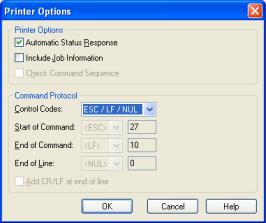
2.Whenever the “CENTRO. MODE” is set to “ECP” in the printer system mode, be sure to set the “PLUG & PLAY” to ON. And, whenever the “CENTRO. MODE” is set to “SPP”, be sure to set the “PLUG & PLAY” to OFF. (The “CENTRO. MODE” and “PLUG & PLAY” have been set to “SPP” and “OFF” as the factory default settings, respectively.
To enable the bi-directional communication, be sure to set the “CENTRO. MODE” to “ECP” and “PLUG & PLAY” to “ON”.
For details of the printer parameter setting, refer to Section 6.2 Parameter Setting on the Printer.
¾If printing is performed with the status monitor enabled though this feature is not available or not necessary, delete the print job and disable the [Printer Status Monitoring].
¾If you start the status monitor by mistake, close the status monitor and disable the [Printer Status Monitoring].
¾When the status monitor is used to monitor the printer statuses, do not install more than one printer driver specifying the same output port in one host PC. When more than one printer driver is installed in a PC, disable the [Printer Status Monitoring]. Also, when multiple computers connect to the same printer, specify that printer as the shared printer or disable the [Printer Status Monitoring.
zWhen Kanji characters are used as bar code font data, click the [Tool] tab – [Configure] button – [Printer Options], and select the “ESC/LF/NUL” for the “Control Codes” of the “Command Protocol”.
¾Bar code font types that accept Kanji data: PDF417, MicroPDF417, Data Matrix, Maxicode, QR code
¾The default setting of the “Control Codes” is “Standard”. Be sure to change this setting when you print Kanji characters as bar code data, otherwise an error results.
- 8 -
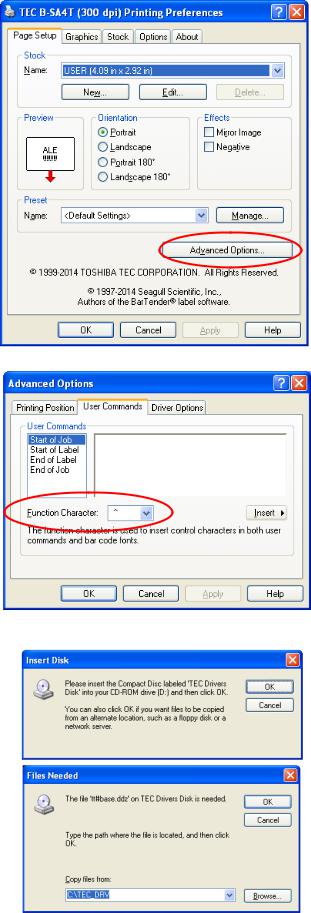
zThe default setting of the function character is a caret “^” (5EH). When using bar code fonts like QR code and if you want to specify a function character as bar code data, you need to specify two function characters consecutively.
For example, when a caret “^” is used as the function character, enter “^ ^” as bar code data.
Click the [Page Setup] tab, [Advanced Options] button, and specify the Function Character.
This is used when binary data is specified as bar code data.
zWhen installing the printer driver via USB with “Plug
&Play” enabled, the messages like “Insert Disk” and “Files Needed” dialog boxes may be displayed. In this case, click the [OK] button in the “Insert Disk” dialog box, and specify the folder (C:\TEC_DRV) for the “Files Needed” dialog box.
- 9 -
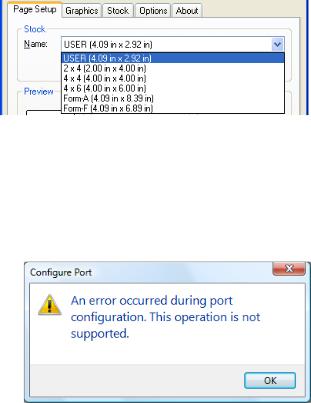
zWhen using this product for the B-EP2DL-G or B-EP4DL-G, set the printer mode to “TPCL-LE”, “TPCL-LE1”, “TPCL”, or “TPCL1” by using the Printer Setting Tool or the keys on the printer. For the key operations, refer to the B-EP Series Key Operation Specification.
zWhen a device font is used, the actual print result looks different from the print preview. Print the label format, and check and adjust the label format.
zRFID fonts are not supported.
zThe stock sizes, A4, A5, and A6, shown in this product do not define the paper size in DEVMODE (DMPAPER_A4, DMPAPER_A5, and DMPAPER_A6). They are the stock IDs unique to this product.
The following table shows the stock IDs for the standard stock types registered to the printer driver. When a new stock type is additionally registered, an ID will be assigned in the order of registration, starting from 257. The stock ID can be changed on the Edit Stock screen. Use these IDs when specifying or checking a stock size of dmPaperSize.
Stock name |
Stock ID |
|
|
Current |
|
Old |
|
|
|
||
USER |
256 |
|
256 |
2x4 |
32000 |
|
257 |
4x4 |
32001 |
|
258 |
4x6 |
32002 |
|
259 |
200x85 |
32004 |
|
260 |
A4 |
32005 |
|
261 |
A5 |
32006 |
|
262 |
A6 |
32007 |
|
263 |
JAMA L |
32010 |
|
267 |
JAMA M |
32011 |
|
268 |
JAMA S |
32012 |
|
269 |
Form-F |
32009 |
|
270 |
Form-A |
32008 |
|
271 |
185x85 |
32003 |
|
272 |
6x4 |
32013 |
|
--- |
2x2 |
32014 |
|
--- |
ATTENTION:
The IDs for the standard stock types have been totally changed from Version 7.2 M-2, which causes mismatching in the IDs between the older printer driver and the new printer driver. Therefore, when printing is performed from the application which manages the stock types for Excel, Access, etc. by their IDs assigned by the older printer driver version, a wrong stock may be selected.
In this case, change the stock IDs back to the former ones using the following procedure.
(1)For the user-added stocks, import the settings of the previous printer driver to the new printer driver. (User-added stocks are imported with their original IDs.)
(2)For the standard stock types, the stock IDs registered to the new printer driver are unchangeable. So, select the standard stock type, click on the [New], and save it as a new stock assigning the former ID listed the table on the left.
The stock list is sorted by ascending order of stock name (Symbol, number, alphabet, Kana, and Kanji), regardless of the stock ID.
zIn the case an export file of the previous version is imported, the preset paper settings may be reset. After importing the preset settings, check the settings.
zWhen Access2007 is used, some paper names may not be correctly shown. To set the paper names, click the [Page Setup] and open the “Edit Stock” dialog.
zWhen the LPT or COM port configuration is changed under Windows Vista/Server2008, conduct it with administrative privilege.
zWhen the port configuration is changed under
Windows Vista/Server2008, the dialog box on the right may be displayed. In this case, change the port configuration with administrative privilege.
- 10 -
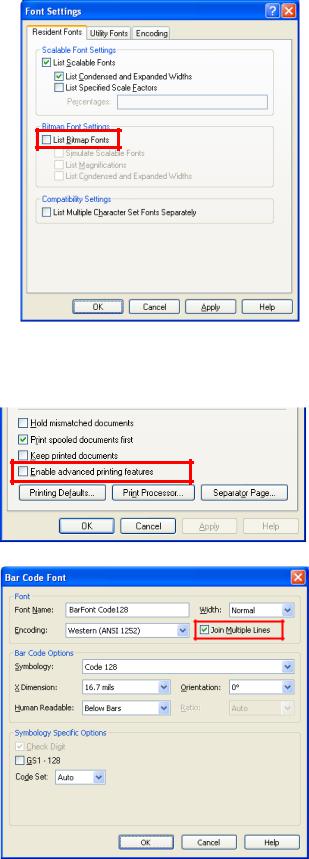
zBitmap fonts cannot be used for Access. When using Access, remove the check from the “List Bitmap Font” checkbox in the “Font Settings” dialog.
zDo not install other Seagull Scientific printer drivers in the PC where this product has been installed. If you installed any by mistake, uninstall the all printer drivers by the DriverWizard, then reinstall this product only.
zWhen printing is performed from an application
created by Active Reports, open the Properties, click the [Advanced] tab, and remove the check from the “Enable advanced printing features” checkbox.
zWhen data with a large number of digits is encoded into a bar code (or 2D code), and if that bar code cannot be printed within a page width, such data will be invalid.
When you use data with a large number of digits, click the [Fonts] tab, select the bar code font, click the [Font] button and the [Edit], then, check the “Join Multiple Lines” checkbox. When this checkbox is checked, every data specifying the same font will be incorporated into one bar code. If you want to print more than one bar code of the same font with this feature enabled, register required number of bar code fonts.
Example: When you want to print three Code128 symbols in a page with the “Join Multiple Lines” enabled, register three Code128 bar code fonts and specify one to one:
Barfont Code128-1
Barfont Code128-2
Barfont Code128-3
- 11 -

zIf data including a space at the beginning or at the end is printed in bar code font, such space is deleted from the data. Multiple data with the same Y-coordinate and same bar code font specified are all connected. To avoid this, click the [Fonts] tab and [Tools] button, select the “Font Settings”, click the [Utility Fonts] tab, then remove the check from the “Combine Adjacent Bar Code & RFID Fields” checkbox.
zIn the case more than one print job is continuously printed, these jobs may not be printed in the order displayed in the print queue. To avoid this, check the checkbox of “Print spooled documents first.”
zWhen the OS is Windows Vista/7/8/10, changing the printer name with “Enable bi-directional support” unchecked may cause the setup information to be non-editable. In this case, check the “Enable bidirectional support” checkbox and click the [OK] button. Then, open the same screen again and remove the check from the “Enable bidirectional support” checkbox.
It is possible to save the setup information by temporarily enabling the bi-directional support after changing the printer name.
zIn the case of Bluetooth communication, click the [Tools] tab and [Setting] button, select the "Printer Option" ,then check the "Bluetooth Connection" checkbox.
Also check the "Enable bidirectional support" checkbox in the [Port] tab.
- 12 -
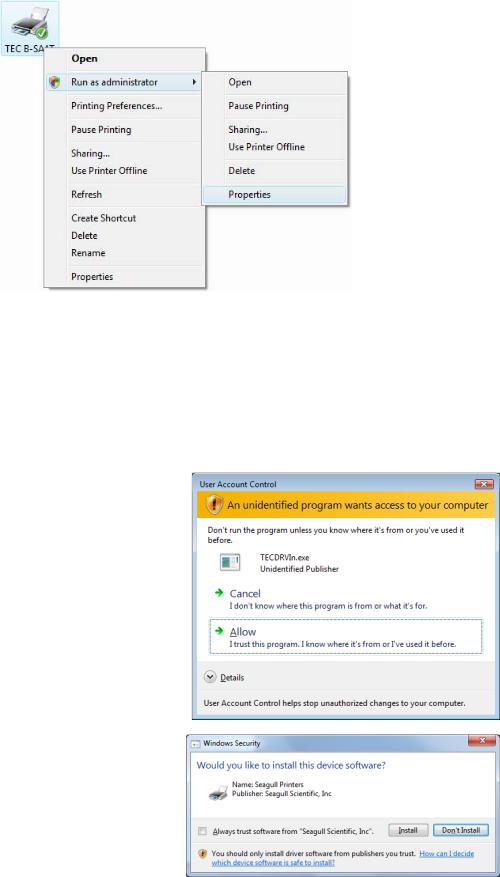
How to open the Properties with the administrative privilege
To change some of the settings under Windows Vista/Server2008, the administrative privilege is necessary. Right-click the printer icon, select the “Run as administrator “, and click the “Properties”.
Note: The “User account control” dialog box may be displayed. In that case, click the [Allow].
How to set up Windows Vista/Server2008/7/Server2008R2/8/Server2012/Server2012R2/10 again
If you uninstall the printer driver, set up the Windows again. This should be also conducted when the installation does not succeed.
1. Select the “Start”, “All programs”, “TOSHIBA TEC”, “TPCL Printer Driver”, and “TECDRVIN”.
Note: Log on as the user with administrative privilege.
The “User account control” dialog may be displayed. In that case, click the [Allow].
2. When the screen on the right appears, click the [Install] button.
- 13 -

If plug-and-play installation fails under Windows Vista/Server2008/7/Server2008R2/8/ Server2012/Server2012R2/10
If an undefined device is created after a plug-and-play installation, follow the procedure below.
1. Select the “Start”, “All programs”, “TOSHIBA TEC”, “TPCL Printer Driver”, and “PnP recovery”.
Note: Log on as the user with administrative privilege.
The “User account control” dialog may be displayed. In that case, click the [Allow].
2. When the screen on the right appears, click the [Install] button.
- 14 -

2. Installation Procedure
The installation procedure of this printer driver differs depending on the printer models and the connection methods. Follow the procedure for the appropriate condition to install the printer driver.
If the older version of this printer driver has been already installed, be sure to uninstall it first, restart the printer, and install the latest printer driver.
) Section 2.10 Uninstalling the Printer Driver.
Preparatory Procedure Common to All Models
Before installing the printer driver, refer to Section 2.1 Preparation for Installation and follow the instructions.
Printer driver installation method
|
|
|
|
{: Connectable |
X: Not connectable |
||
Printer model |
|
|
|
Connection method |
|
|
|
|
Plug and Play is not used. |
|
Plug and Play is used. |
||||
|
RS232C |
|
LAN |
Parallel |
Bluetooth |
USB |
Parallel |
B-SX8T (305 dpi) |
{ |
|
{ |
{ |
X |
{ |
{ |
B-SX6T (305 dpi) |
{ |
|
{ |
{ |
X |
{ |
{ |
B-SV4 |
{ |
|
{ |
{ |
X |
{ |
X |
B-EV4 (203 dpi), |
{ |
|
{ |
{ |
X |
{ |
X |
B-EV4 (300 dpi) |
|
|
|
|
|
|
|
B-EP2DL-G |
{ |
|
{ |
X |
{ |
{ |
X |
B-EP4DL-G |
{ |
|
{ |
X |
{ |
{ |
X |
B-452-R |
{ |
|
{ |
{ |
X |
{ |
{ |
B-462-R |
{ |
|
{ |
{ |
X |
{ |
{ |
B-852-R |
{ |
|
{ |
{ |
X |
{ |
{ |
B-SA4T (203 dpi), |
{ |
|
{ |
{ |
X |
{ |
{ |
B-SA4T-CN (203 dpi), |
|
|
|
|
|
|
|
B-SA4T (300 dpi), |
|
|
|
|
|
|
|
B-SA4T-CN (300 dpi) |
|
|
|
|
|
|
|
B-SX4T (203 dpi), |
{ |
|
{ |
{ |
X |
{ |
{ |
B-SX4T-CN (203 dpi) |
|
|
|
|
|
|
|
B-SX5T (305 dpi), |
{ |
|
{ |
{ |
X |
{ |
{ |
B-SX5T-CN (305 dpi) |
|
|
|
|
|
|
|
B-EX4T1 (203 dpi), |
{ |
|
{ |
{ |
X |
{ |
{ |
B-EX4T1 (305 dpi) |
|
|
|
|
|
|
|
B-EX4T2 (203 dpi), |
{ |
|
{ |
{ |
X |
{ |
{ |
B-EX4T2 (300 dpi), |
|
|
|
|
|
|
|
B-EX4T2 (600 dpi), |
|
|
|
|
|
|
|
B-EX4D2 (203 dpi), |
|
|
|
|
|
|
|
B-EX6T1 (203 dpi) |
{ |
|
{ |
{ |
X |
{ |
{ |
B-EX6T1 (305 dpi) |
|
|
|
|
|
|
|
B-EX6T3 (203 dpi) |
{ |
|
{ |
{ |
X |
{ |
{ |
B-EX6T3 (305 dpi) |
|
|
|
|
|
|
|
B-FV4 (203 dpi), |
{ |
|
{ |
{ |
X |
{ |
X |
B-FV4 (300 dpi) |
|
|
|
|
|
|
|
B-FP3D (203 dpi) |
X |
|
{ |
X |
{ |
{ |
X |
Note: The above table does not show the all interface types that each printer supports.
Check that your actual connection method is { (connectable), refer to the Installation method by operating systems on the following page, and follow the appropriate installation procedure.
- 15 -
Installation method by operating systems
|
|
|
|
|
Connection method |
|
OS |
Plug and Play is not used. |
Plug and Play is used. |
||||
|
RS-232C |
LAN |
Parallel |
Bluetooth |
USB |
Parallel (*1) |
Windows |
Section 2.2 Install under Windows |
Section 2.4 Install under |
Section 2.7 Install under |
|||
2000 |
2000/XP/Server2003 |
Windows 2000 (USB interface |
Windows 2000 (Parallel |
|||
|
|
|
|
|
with plug and play enabled) |
interface with plug and play |
|
|
|
|
|
|
enabled) |
Windows XP |
|
|
|
|
Section 2.5 Install under |
Section 2.8 Install under |
Windows |
|
|
|
|
Windows XP/Server2003 (USB |
Windows XP/Server2003 |
Server 2003 |
|
|
|
|
interface with plug and play |
(Parallel interface with plug |
|
|
|
|
|
enabled.) |
and play enabled) |
Windows |
Section 2.3 Install under Windows |
Section 2.6 Install under |
Section 2.9 Install under |
|||
Vista |
Vista/Server2008/7/ |
Windows Vista/Server2008/7/ |
Windows |
|||
Windows |
Server2008R2/8/Server |
Server2008R2/8/Server2012/Se |
Vista/Server2008/7 / |
|||
Server 2008 |
2012/Server2012R2/ 10 |
rver2012R2/10 (USB |
Server2008R2/8/Server2012 |
|||
Windows 7 |
|
|
|
|
connection with plug and play |
/Server2012R2/10 (Parallel |
Windows |
|
|
|
|
enabled) |
interface with plug and play |
Server 2008 |
|
|
|
|
|
enabled) |
R2 |
|
|
|
|
|
|
Windows 8 |
|
|
|
|
|
|
Windows 10 |
|
|
|
|
|
|
*1: If you choose the parallel interface with plug and play enabled, you need to change some parameter settings on the printer. The “plug and play” feature has been disabled as default for the parallel interface connection. See the following.
In the case installing a shared printer, follow the procedure described in “To print on the shared printer” in
Section 2.2 Installation under Windows 2000/XP/Server2003 and Section 2.3 Installation under Windows Vista/Server2008/7/Server2008R2/8/Server2012/Server2012R2/10. When you want to use Plug and Play, follow the above procedure.
z Printer parameter settings when installing the printer driver via parallel interface with plug and play enabled:
B-SX4 Series and B-SX5 Series
Start the printer in the system mode, enter the <2>PARAMETER SET menu, and set the following parameters as below:
CENTRO. MODE: ....................................... |
ECP (Default: SPP) Enables an installation of the printer driver |
|
with plug and play |
PLUG & PLAY: ON (Default: OFF)........... |
Enables monitoring the printer status. () Status Window |
|
Preferences in Section 3.6 Tools Tab.) |
When you use the bi-directional communication, set the CENTRO. MODE to ECP and PLUG & PLAY to ON, respectively. The parameter setting procedure is provided in Section 6.2 Parameter Setting on the Printer.
B-SA4 Series, B-852-R, B-452-R, B-SX6T-R, B-SX8T-R, B-EX4 Series and B-462-R
Start the printer in the system mode, enter <2>PARAMETER SET menu, and set the following parameter: PLUG & PLAY: ON (Default: OFF)........... Enables an installation of the printer driver with plug and play
Since the printer status monitor cannot be used, disable the “Bi-directional support” in the Properties of the printer driver.
- 16 -
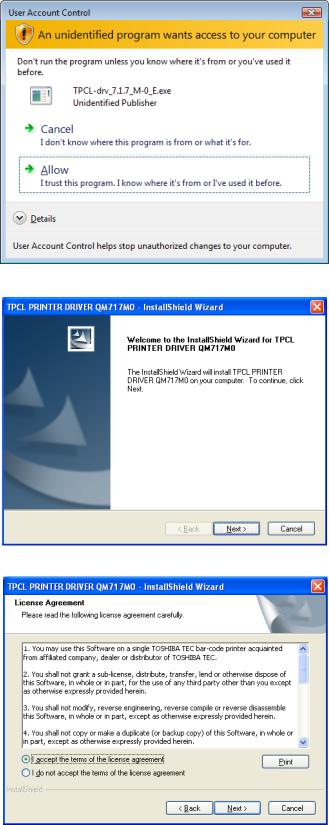
2.1Preparation for Installation
1.Access Toshiba TEC web site at the following address and download the printer driver install file “TPCL-drv_7.4.1_M-3_E.exe” to the local disc.
http://www.toshibatec-ris.com/download_overseas/printer/printer_driver/
Note: If you do not agree with the Software License Agreement, you cannot download the file.
2. Double-click the downloaded “TPCL-drv_7.4.1_M-3_E.exe”, and the “TPCL PRINTER DRIVER – Installshield Wizard” is displayed. Click the [Next] button.
Note: Log on as the user with administrative privilege. When the User Account Control screen is displayed under Windows Vista/Server2008/7/Server2008R2/8/Server201 2/Server2012R2/10, click on the “Allow”.
3. The “Software License Agreement” is displayed. Select “I accept the terms of the license agreement” and click the [Next] button.
Note: If you do not agree with the Software License Agreement, you cannot download the file.
- 17 -
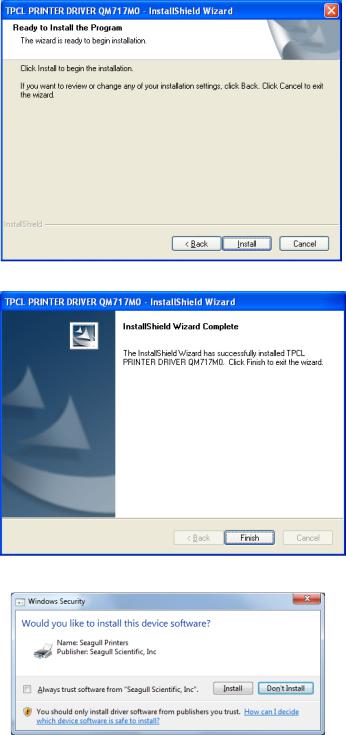
4. When you click the [Install] button, the printer driver install file is created in “C:\TEC_DRV”.
Note: The folder name cannot be changed from “C:\TEC_DRV”.
5. When the installation is completed, click the [Finish] button.
Note: In the case of Windows Vista/Server2008/7/ Server2008R2/8/Server2012/Server2012R2/10, the screen on the right will appear. Click the [Install] button.
- 18 -
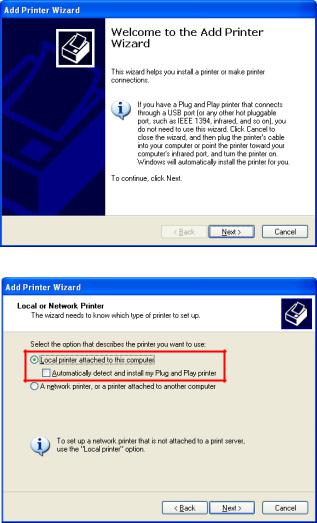
2.2Installation under Windows 2000/XP/Server2003
Note: Proper operation is not guaranteed on the PC running Windows 2000.
1.
2.
Turn on the PC.
Note: Log on as the user with administrative privilege.
Select the “Start”, “Printer and FAX” to show the printer folder.
Supplement: In the case of Windows 2000, select “Start”, “Setting”, and “Printer”. If the “Printer and FAX” folder is not found, click the “Control Panel” and select the “Printer and FAX”.
In the case of the category view, click the “Printer and Other Hardware” and select the “Printer and FAX”.
3.
4.
Select the “Add printer” from the File menu. The “Add Printer Wizard” is displayed.
Click the [Next] button in the “Add Printer Wizard”.
5. Select the “Local printer attached to this computer” and click the [Next] button.
Note: Do not check the “Automatically detect and install my Plug and Play printer” checkbox.
Even in the case of specifying the network printer or a printer connected to other PC, be sure to choose the local printer in this step. This setting is changed after the installation is completed. ()To print on the shared printer.)
- 19 -
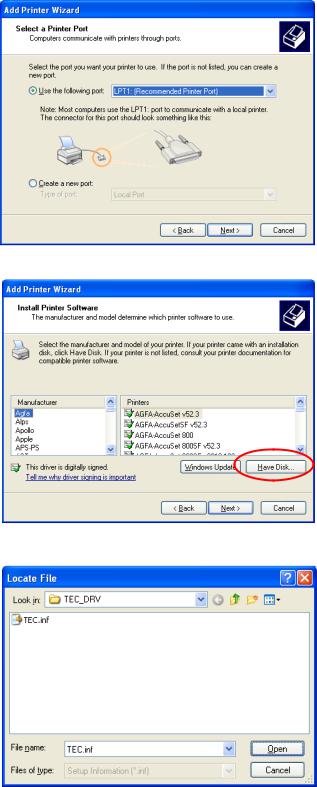
6. Specify a printer port and click the [Next] button.
7. When the “Install Printer Software” screen appears, click the [Have Disk] button.
8. Specify the printer driver install folder (C:/TEC_DRV) created in Section 2.1 Preparation for Installation, and click the [Open] button. Select the “TEC.inf” and click the [OK] button.
- 20 -

9. The list of the installable printer is displayed.
Driver name |
Model |
TEC B-852-R |
B-852-TS22-QQ-R |
|
B-852-TS22-QP-R |
|
|
TEC B-SA4T-CN |
B-SA4TP-GS12-CN-R |
(203 dpi) |
|
|
|
TEC B-SX4T |
B-SX4T-GS10-QQ |
(203 dpi) |
B-SX4T-GS10-QQ-US |
|
B-SX4T-GS10-QP |
|
B-SX4T-GS20-QQ |
|
B-SX4T-GS20-QQ-US |
|
B-SX4T-GS20-QP |
|
B-SX4T-GS20-QM-R |
TEC B-SX5T-CN |
B-SX5T-TS12-CN |
(305 dpi) |
B-SX5T-TS22-CN |
|
B-SX5T-TS22-CN-R |
TEC B-452-R |
B-452-TS22-QQ/QP-R |
|
B-452-TS22-CN |
|
|
TEC B-EV4 (203 |
B-EV4D-GS14-QM-R |
dpi) |
B-EV4T-GS14-QM-R |
|
|
TOSHIBA |
B-EX4T1-TS12-QM-R |
B-EX4T1 (305 |
B-EX4T1-TS12-CN-R |
dpi) |
|
|
|
TOSHIBA |
B-EX4T2-HS12-QM-R |
B-EX4T2 (600 dpi) |
B-EX4T2-HS12-CN-R |
|
|
TOSHIBA |
B-FV4T-GS12-QM-R |
B-FV4 (203 dpi) |
B-FV4T-GS14-QM-R |
|
B-FV4T-GS16-QM-R |
|
B-FV4T-GS14-CN-R |
|
B-FV4T-GS16-CN-R |
|
B-FV4D-GS12-QM-R |
|
B-FV4D-GS14-QM-R |
|
B-FV4D-GS16-QM-R |
|
B-FV4D-GS14-CN-R |
|
B-FV4D-GS16-CN-R |
|
B-FV4D-GH14-QM-R |
|
B-FV4D-GL14-QM-R |
TOSHIBA |
B-EX6T1-TS12-QM-R |
B-EX6T1 (305 |
B-EX6T1-TS12-CN-R |
dpi) |
|
Driver name |
Model |
|
TEC B-SA4G |
B-SA4TM-GS12-QM-R |
|
(203 dpi) |
B-SA4TP-GS12-QM-R |
|
|
|
|
TEC |
B-SA4TM-TS12-CN |
|
B-SA4TP-TS12-CN |
||
B-SA4T-CN |
||
(300 dpi) |
|
|
|
|
|
TEC |
B-SX4T-GS10-CN |
|
B-SX4T-CN |
B-SX4T-GS20-CN |
|
(203 dpi) |
B-SX4T-GS20-CN-R |
|
|
|
|
TEC B-SX6T |
B-SX6T-TS12-QM-R |
|
(305 dpi) |
|
|
|
|
|
TEC |
B-EP2DL-GH20-QM-R |
|
B-EP2DL-G |
B-EP2DL-GH30-QM-R |
|
|
B-EP2DL-GH40-QM-R |
|
TEC B-EV4 |
B-EV4D-TS14-QM-R |
|
(305 dpi) |
B-EV4T-TS14-QM-R |
|
|
|
|
TOSHIBA |
B-EX4T2-GS12-QM-R |
|
B-EX4T2 (203 |
B-EX4T2-GS12-CN-R |
|
dpi) |
B-EX4D2-GS12-QQ-R |
|
|
B-EX4D2-GS12-QM-R |
|
TEC B-462-R |
B-462-TS22-CN-R |
|
|
|
|
TOSHIBA |
B-FV4T-TS12-QM-R |
|
B-FV4 (300 dpi) |
B-FV4T-TS14-QM-R |
|
|
B-FV4T-TS16-QM-R |
|
|
B-FV4T-TS14-CN-R |
|
|
B-FV4T-TS16-CN-R |
|
|
B-FV4D-TS12-QM-R |
|
|
B-FV4D-TS14-QM-R |
|
|
B-FV4D-TS16-QM-R |
|
|
B-FV4D-TS14-CN-R |
|
|
B-FV4D-TS16-CN-R |
|
|
|
|
TOSHIBA |
B-EX6T3-GS12-QM-R |
|
B-EX6T3 (203 |
B-EX6T3-GS12-CN-R |
|
dpi) |
|
Driver name |
Model |
|
TEC B-SA4T |
B-SA4TM-TS12-QM-R |
|
(300 dpi) |
B-SA4TP-TS12-QM-R |
|
|
|
|
TEC B-SV4 |
B-SV4D-GS10-QM |
|
|
B-SV4D-GC10-QM |
|
|
B-SV4D-GS10-QM-R |
|
|
B-SV4D-GC10-QM-R |
|
|
B-SV4D-GS10-CN |
|
|
B-SV4D-GH10-QQ-US |
|
|
B-SV4T-GS10-QM-R |
|
TEC B-SX5T |
B-SX5T-TS12-QQ |
|
(305 dpi) |
B-SX5T-TS12-QQ-US |
|
|
B-SX5T-TS12-QP |
|
|
B-SX5T-TS22-QQ |
|
|
B-SX5T-TS22-QQ-US |
|
|
B-SX5T-TS22-QP |
|
|
B-SX5T-TS22-QM-R |
|
TEC B-SX8T |
B-SX8T-TS12-QM-R |
|
(305 dpi) |
|
|
|
|
|
TEC |
B-EP4DL-GH20-QM-R |
|
B-EP4DL-G |
B-EP4DL-GH30-QM-R |
|
|
B-EP4DL-GH40-QM-R |
|
TOSHIBA |
B-EX4T1-GS12-QM-R |
|
B-EX4T1 (203 |
B-EX4T1-GS12-CN-R |
|
dpi) |
|
|
TOSHIBA |
B-EX4T2-TS12-QM-R |
|
B-EX4T2 (300 |
B-EX4T2-TS12-CN-R |
|
dpi) |
|
|
|
|
|
TOSHIBA |
B-FP3D-GH30-QM-R |
|
B-FP3D (203 |
B-FP3D-GH40-QM-R |
|
dpi) |
||
B-FP3D-GS30-QM-R |
||
|
||
|
B-FP3D-GS40-QM-R |
|
TOSHIBA |
B-EX6T1-GS12-QM-R |
|
B-EX6T1 (203 |
B-EX6T1-GS12-CN-R |
|
dpi) |
|
TOSHIBA B-EX6T3-TS12-QM-R B-EX6T3 (305 B-EX6T3-TS12-CN-R dpi)
- 21 -
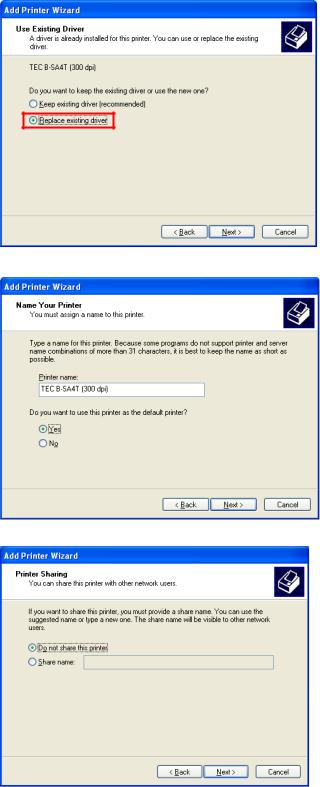
10.
11.
Select the model to be installed, and click the [Next] button.
Select the “Replace existing driver”, and click the [Next] button.
Supplement: This step will be omitted when the printer driver is installed for the first time.
12. Select whether or not to use the printer as a default printer, then click the [Next] button.
13. Select whether or not to share the printer with other users on the network, then click the [Next] button.
- 22 -
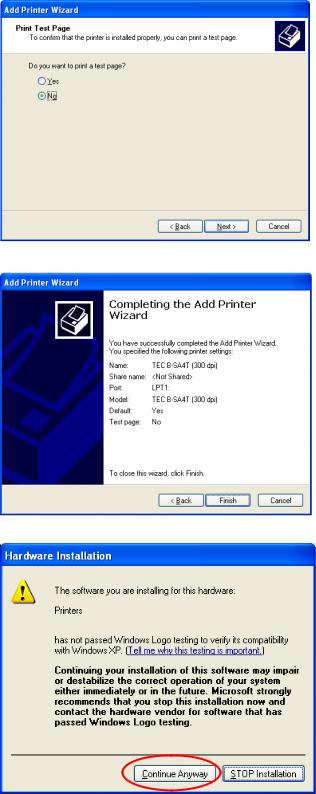
14. Select whether or not to perform a print test, then click the [Next] button.
15. When the “Completing the Add Printer Wizard” is displayed, click the [Finish] button.
16. When the screen on the right appears, click the [Continue Anyway] button.
Note: “Digital Signature Not Found” message may be displayed. In that case, click the [Yes] button.
17.
18.
Installation of the printer driver starts.
When the installation is completed, a new printer icon will be added to the “Printer” folder.
- 23 -
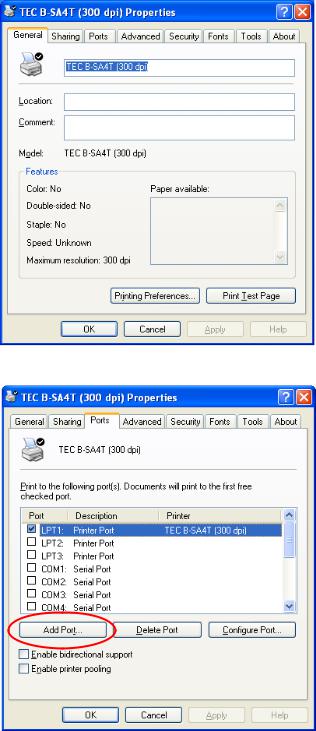
To print on the shared printer
1.Conduct above-mentioned steps 1 through 18.
2.Log on as the user which is allowed to access the PC with which the printer is shared.
Note: This work requires the administrative privilege. For the user with no administrative privilege, grant it temporarily.
3. Right-click the newly added icon, and select the “Properties” to open the “Properties” screen.
4. Click the [Port] tab, then click the [Add Port] button.
- 24 -
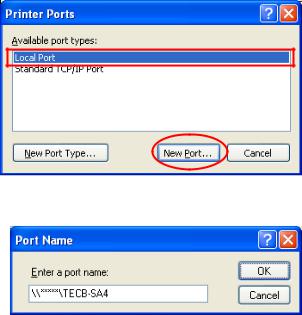
5. Select the “Local Port”, and click the [New Port] button.
6. Enter the network path of the shared printer (e.g. \\*****\TECB-SA4), then click the [OK] button.
7. When the port setting is completed, click the [OK] button to close the “Properties” screen.
Note: After installing this printer driver, be sure to disable the Bi-directional support. For details, refer to Section
6.1 How to Enable Bi-directional Communication Support.
Since the setup information is stored in each PC that shares the printer, please configure the printer driver settings after the completion of the port setting.
- 25 -
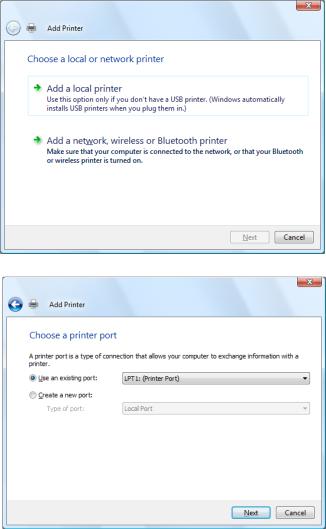
2.3 Installation under Windows Vista/Server2008/7/Server2008R2/8/Server2012/Server2012R2/1 0
Note: If the installation did not succeed, follow the procedure described in How to set up Windows
Vista/Server2008/7/Server2008R2/8/Server2012/Server2012R2/10 again.
1.
2.
Turn on the PC.
Note: Log on as the user with administrative privilege.
Select “Start”, “Control Panel”, “Hardware and Sound”, and “Printer” to open the printer folder.
Supplement: Entering “Printer” in the Search box of the Start menu causes the “Printer” to be shown in the Program.
3.
4.
Click the “Install a Printer” to start adding a printer.
Select the “Add a local printer”.
5. Select a printer port, and click the [Next] button.
- 26 -
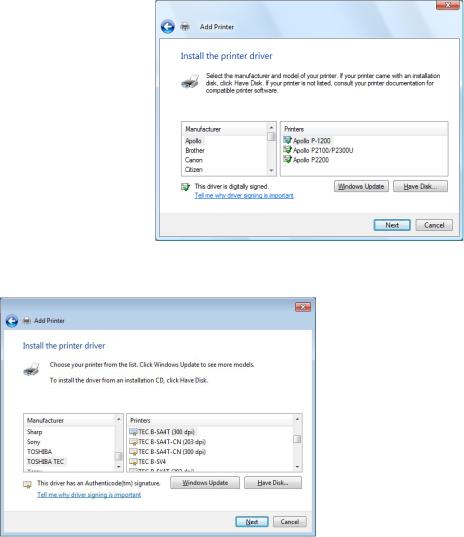
6. When the screen on the right appears, select “TEC” from the Manufacturer list.
7. The list of the installable printer models are displayed.
Driver name |
Model |
Driver name |
Model |
Driver name |
Model |
TEC B-852-R |
B-852-TS22-QQ-R |
TEC B-SA4T |
B-SA4TM-GS12-QM-R |
TEC B-SA4T |
B-SA4TM-TS12-QM-R |
|
B-852-TS22-QP-R |
(203 dpi) |
B-SA4TP-GS12-QM-R |
(300 dpi) |
B-SA4TP-TS12-QM-R |
|
|
|
|
|
|
TEC |
B-SA4TP-GS12-CN-R |
TEC |
B-SA4TM-TS12-CN |
TEC B-SV4 |
B-SV4D-GS10-QM |
B-SA4T-CN |
|
B-SA4T-CN |
B-SA4TP-TS12-CN |
|
B-SV4D-GC10-QM |
(203 dpi) |
|
|
|
B-SV4D-GS10-QM-R |
|
|
(300 dpi) |
|
|
||
|
|
|
|
B-SV4D-GC10-QM-R |
|
|
|
|
|
|
|
|
|
|
|
|
B-SV4D-GS10-CN |
|
|
|
|
|
B-SV4D-GH10-QQ-US |
|
|
|
|
|
B-SV4T-GS10-QM-R |
TEC B-SX4T |
B-SX4T-GS10-QQ |
TEC |
B-SX4T-GS10-CN |
TEC B-SX5T |
B-SX5T-TS12-QQ |
(203 dpi) |
B-SX4T-GS10-QQ-US |
B-SX4T-CN |
B-SX4T-GS20-CN |
(305 dpi) |
B-SX5T-TS12-QQ-US |
|
B-SX4T-GS10-QP |
(203 dpi) |
B-SX4T-GS20-CN-R |
|
B-SX5T-TS12-QP |
|
B-SX4T-GS20-QQ |
|
|
|
B-SX5T-TS22-QQ |
|
B-SX4T-GS20-QQ-US |
|
|
|
B-SX5T-TS22-QQ-US |
|
B-SX4T-GS20-QP |
|
|
|
B-SX5T-TS22-QP |
|
B-SX4T-GS20-QM-R |
|
|
|
B-SX5T-TS22-QM-R |
TEC |
B-SX5T-TS12-CN |
TEC B-SX6T |
B-SX6T-TS12-QM-R |
TEC B-SX8T |
B-SX8T-TS12-QM-R |
B-SX5T-CN |
B-SX5T-TS22-CN |
(305 dpi) |
|
(305 dpi) |
|
(305 dpi) |
B-SX5T-TS22-CN-R |
|
|
|
|
TEC B-452-R |
B-452-TS22-QQ/QP-R |
TEC |
B-EP2DL-GH20-QM-R |
TEC |
B-EP4DL-GH20-QM-R |
|
B-452-TS22-CN |
B-EP2DL-G |
B-EP2DL-GH30-QM-R |
B-EP4DL-G |
B-EP4DL-GH30-QM-R |
|
|
|
B-EP2DL-GH40-QM-R |
|
B-EP4DL-GH40-QM-R |
TEC B-EV4 |
B-EV4D-GS14-QM-R |
TEC B-EV4 |
B-EV4D-TS14-QM-R |
TOSHIBA |
B-EX4T1-GS12-QM-R |
(203 dpi) |
B-EV4T-GS14-QM-R |
(300 dpi) |
B-EV4T-TS14-QM-R |
B-EX4T1 (203 |
B-EX4T1-GS12-CN-R |
|
|
|
|
dpi) |
|
TOSHIBA |
B-EX4T1-TS12-QM-R |
TOSHIBA |
B-EX4T2-GS12-QM-R |
TOSHIBA |
B-EX4T2-TS12-QM-R |
B-EX4T1 |
B-EX4T1-TS12-CN-R |
B-EX4T2 (203 |
B-EX4T2-GS12-CN-R |
B-EX4T2 (300 |
B-EX4T2-TS12-CN-R |
(305 dpi) |
|
dpi) |
B-EX4D2-GS12-QQ-R |
dpi) |
|
|
|
|
B-EX4D2-GS12-QM-R |
|
|
- 27 -
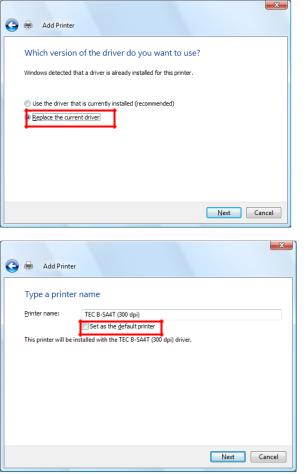
Driver name |
Model |
Driver name |
Model |
Driver name |
Model |
TOSHIBA |
B-EX4T2-HS12-QM-R |
TEC B-462-R |
B-462-TS22-CN-R |
TOSHIBA |
B-FP3D-GH30-QM-R |
B-EX4T2 |
B-EX4T2-HS12-CN-R |
|
|
B-FP3D (203 |
B-FP3D-GH40-QM-R |
(600 dpi) |
|
|
|
dpi) |
|
|
|
|
B-FP3D-GS30-QM-R |
||
|
|
|
|
|
|
|
|
|
|
|
B-FP3D-GS40-QM-R |
TOSHIBA |
B-FV4T-GS12-QM-R |
TOSHIBA |
B-FV4T-TS12-QM-R |
TOSHIBA |
B-EX6T1-GS12-QM-R |
B-FV4 (203 |
B-FV4T-GS14-QM-R |
B-FV4 (300 |
B-FV4T-TS14-QM-R |
B-EX6T1 (203 |
B-EX6T1-GS12-CN-R |
dpi) |
B-FV4T-GS16-QM-R |
dpi) |
B-FV4T-TS16-QM-R |
dpi) |
|
|
B-FV4T-GS14-CN-R |
|
B-FV4T-TS14-CN-R |
|
|
|
B-FV4T-GS16-CN-R |
|
B-FV4T-TS16-CN-R |
|
|
|
B-FV4D-GS12-QM-R |
|
B-FV4D-TS12-QM-R |
|
|
|
B-FV4D-GS14-QM-R |
|
B-FV4D-TS14-QM-R |
|
|
|
B-FV4D-GS16-QM-R |
|
B-FV4D-TS16-QM-R |
|
|
|
B-FV4D-GS14-CN-R |
|
B-FV4D-TS14-CN-R |
|
|
|
B-FV4D-GS16-CN-R |
|
B-FV4D-TS16-CN-R |
|
|
|
B-FV4D-GH14-QM-R |
|
|
|
|
|
B-FV4D-GL14-QM-R |
|
|
|
|
TOSHIBA |
B-EX6T1-TS12-QM-R |
TOSHIBA |
B-EX6T3-GS12-QM-R |
TOSHIBA |
B-EX6T3-TS12-QM-R |
B-EX6T1 |
B-EX6T1-TS12-CN-R |
B-EX6T3 |
B-EX6T3-GS12-CN-R |
B-EX6T3 (305 |
B-EX6T3-TS12-CN-R |
(305 dpi) |
|
(203 dpi) |
|
dpi) |
|
8.
9.
Select a model to be installed, then click the [Next] button.
Select the “Replace the current driver”, and click the [Next] button.
Supplement: This step will be omitted when the printer driver is installed for the first time.
10. Select whether or not to use the printer as a default printer, then click the [Next] button.
11. Installation starts.
- 28 -
